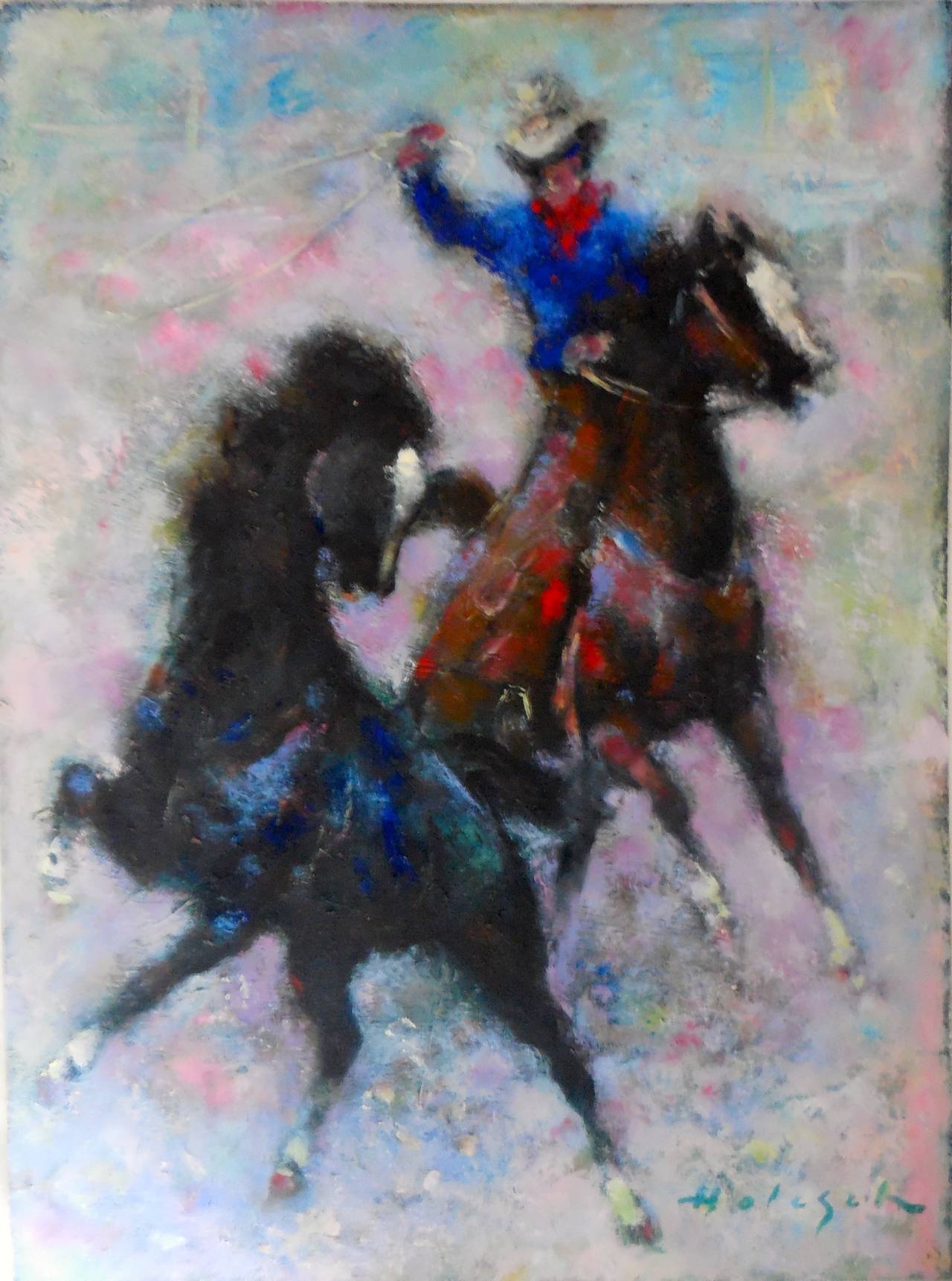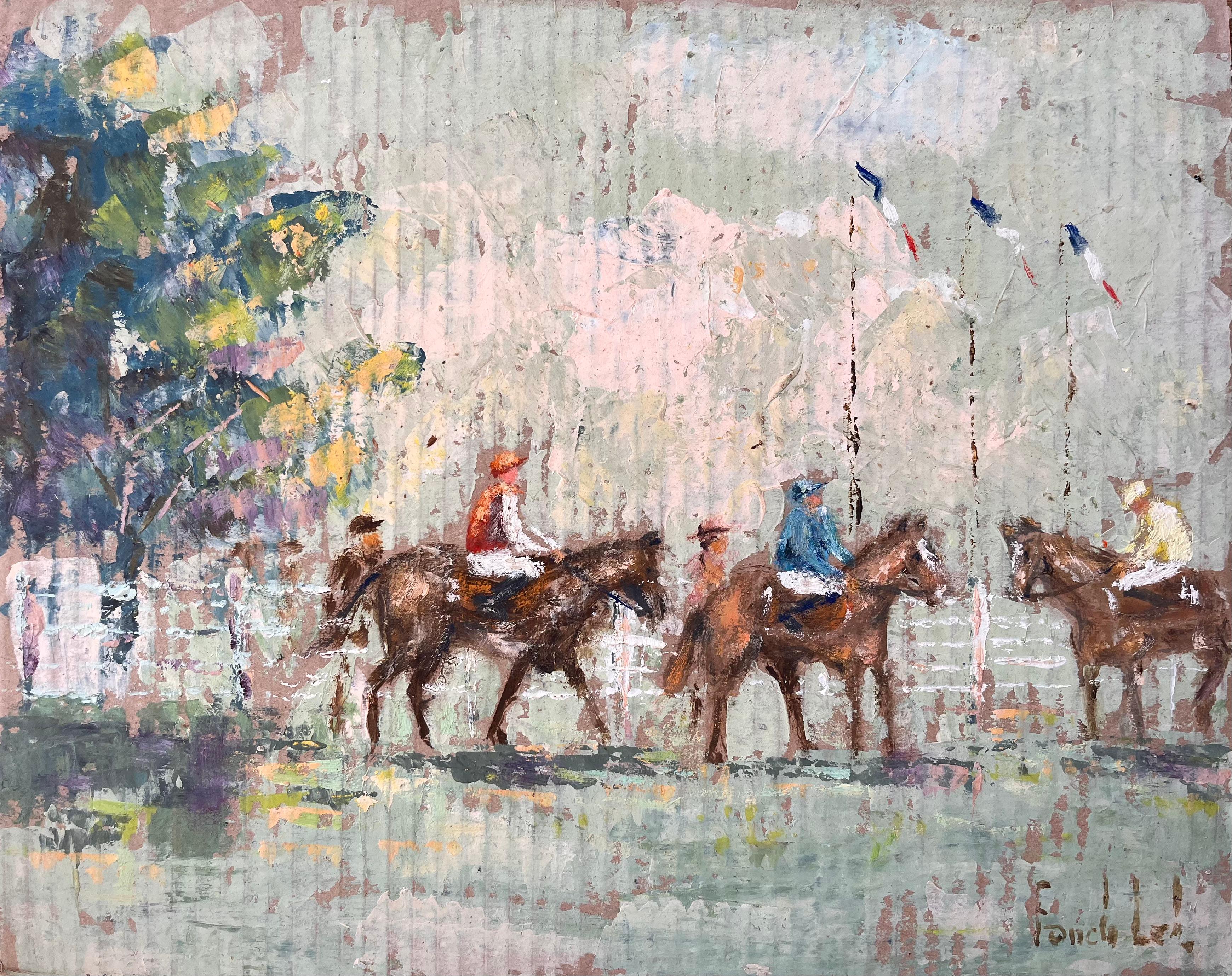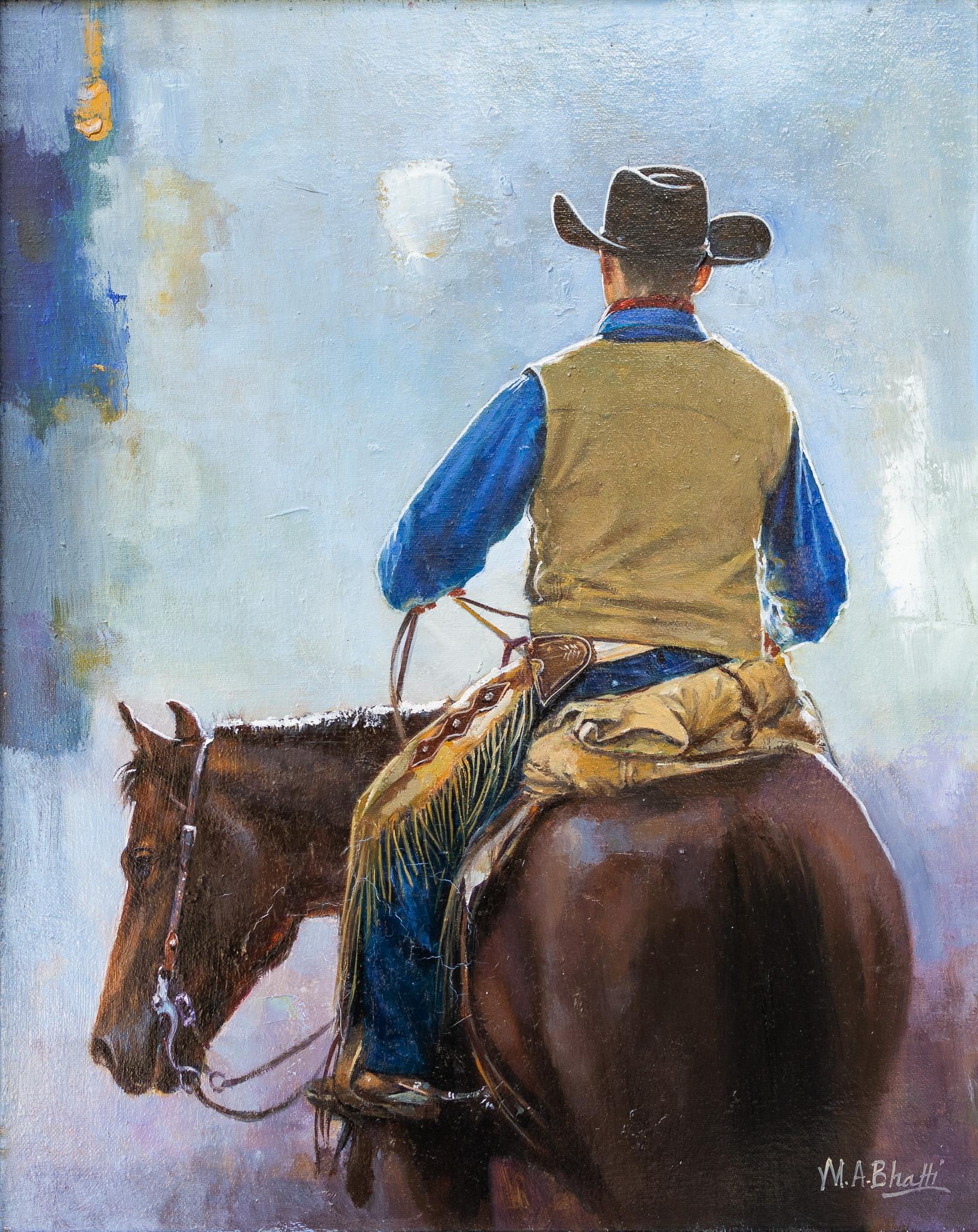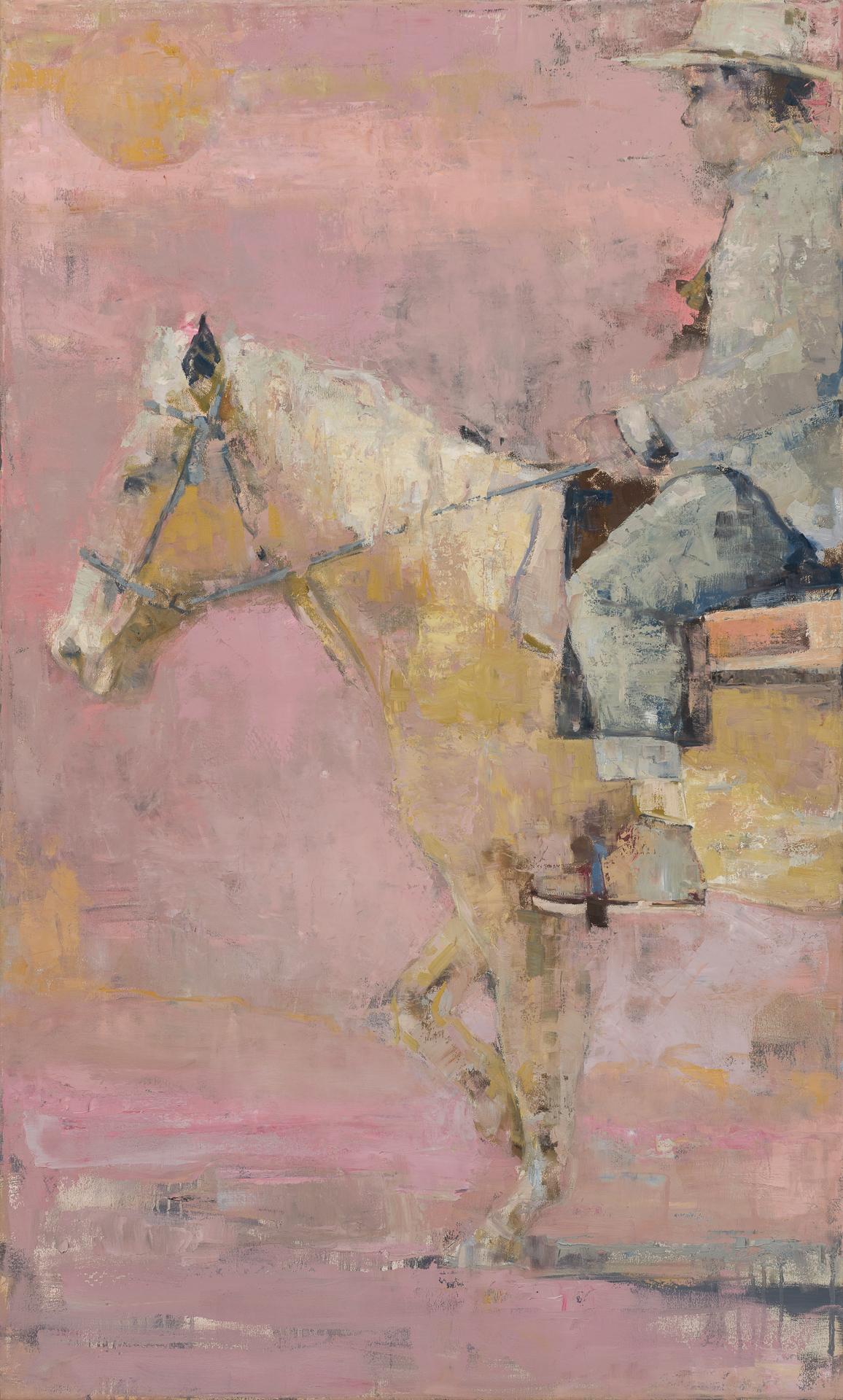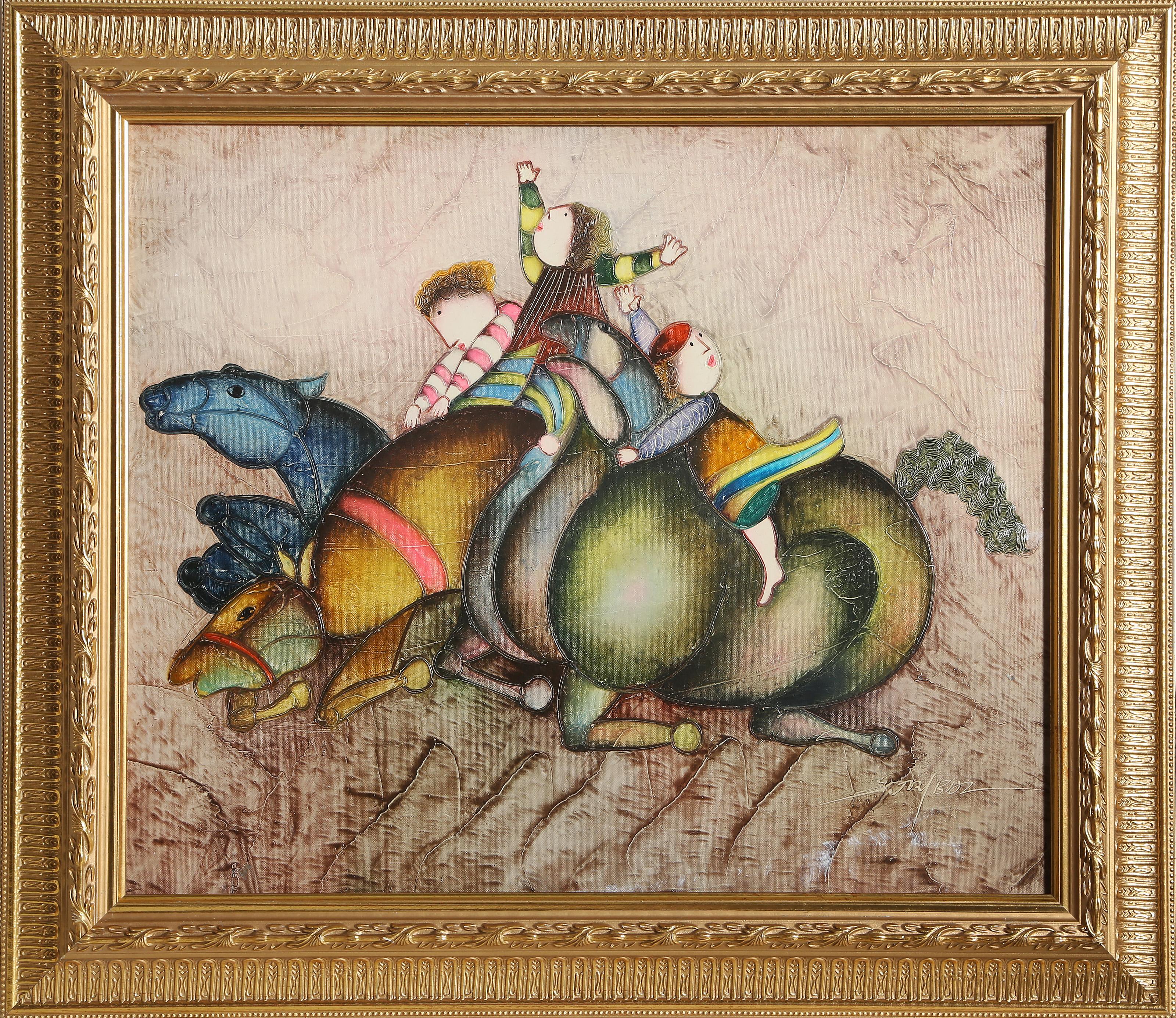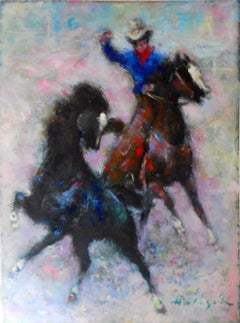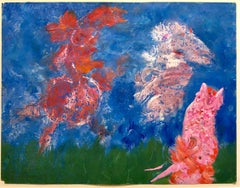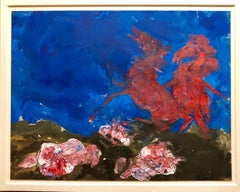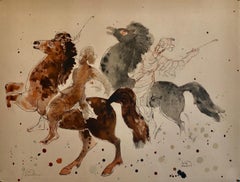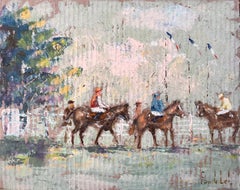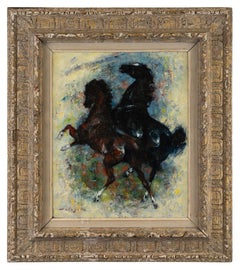Items Similar to Cowboys on Horseback, Rodeo
Want more images or videos?
Request additional images or videos from the seller
1 of 2
Denes de HoleschCowboys on Horseback, Rodeo
$1,600
£1,187.26
€1,383
CA$2,227.21
A$2,480.20
CHF 1,290.81
MX$30,580.58
NOK 16,439.42
SEK 15,451.46
DKK 10,318.88
Shipping
Retrieving quote...The 1stDibs Promise:
Authenticity Guarantee,
Money-Back Guarantee,
24-Hour Cancellation
About the Item
This is an oil on canvas by the important Hungarian-born and internationally celebrated Denes de Holesch (1910-1983).this is the original rare oil painting.
Denes de Holesch was an international equestrian artist. His works have been exhibited all over the world, including in New York, Beverly Hills, Boston, Chicago, Paris, Mexico City, Montreal, Tokyo, Sydney, and Madrid. His horse paintings fall into one of seven themes, including polo, cowboys, circus, rodeo, hunt, bull-fight, race-course and running free. His mastery of the subject has been compared to that of Picasso, Delacroix and Franc Marc.
1910 Denes Dezo George de Holesch was born on 9 February, 1910 at Banska-Bystrica, Northern Hungary. He was the third child and youngest son of Hugo de Holesch, an architect and Margit, nee Wagner. Many generations of the de Holesch family had worked as professional architects. He studied at the Hungarian Academy of Fine Arts in Budapest on a scholarship. Early in his career he traveled to China, Japan, Philippines, Java, Bali and Australia, where his reputation grew rapidly. Here he produced portraits in oils, and lithographs of the Chinese, as well as landscape works in oils,depicting the local countryside, and canal, street and city scenes. His exposure to the arts of the Chinese, with their simplicity of line, greatly influenced his later works. In 1939 he established a studio at Lavender Bay near Sydney. In 1940 he exhibited at the Macquarie Galleries in Sydney. In 1944 he married Joyce Greer, the Melbourne concert pianist. In 1945 the couple moved to New York where his interest in horses grew. He held exhibitions at Gallery Wildenstein, Herve, and FAR Gallery. In 1946 Holesch moved to Montreal where he exhibited at the National Gallery of Montreal. In 1947 he moved to Boston where he continued painting portraits and horses. He exhibited there at the Ehrmann and Vose galleries. Later in the year he moved to San Francisco where he was invited to participate in the "Renoir to Picasso" Exhibition held at the Maxwell Gallery.1946 He moved to Montreal, Canada and exhibited at the National Gallery of Montreal. (Frederic Remington and Charles Russell)
1947 Early in the year he moved to Boston and continued painting portraits and horses. In June, he painted the portrait of Harvard Law School Dean, Erwin N. Griswold, and in October his works were exhibited at Margaret Brown's Galerie Intime, Newbury Street, Boston.
1948 He produced a clay sculpture head of Egon Petri, one of a number of clay sculptures that he produced. He also produced a number of wood carvings. His paintings were chosen for inclusion in a Group Exhibition in the National Gallery of San Francisco, and in the important and prestigious 'Renoir to Picasso' Exhibition held at Maxwell's Galleries, 372 Sutter Street, San Francisco.
1953 His works were included in a Group Impressionists Exhibition held at the Ohana Gallery, London
1954 He travelled to New York, where he was commissioned to paint Herbert Gasser, Nobel Prize Winner in Biochemistry.
1955 He returned to England, and then travelled to Paris to exhibit works in the Galerie Marcel Lenoir.
1956 He again returned to New York to work on portrait commissions and for exhibitions of his works, mainly of horses. These exhibitions were held in New York, Boston, San Francisco and late in the year at the Galleries of Frank J. Oehlschlaeger at 107 East Oak Street, Chicago. During this year, visits with his family to Ringling Circus and to a rodeo in Tucson, Arizona must have impressed him greatly, for images of these events soon appeared on his canvases. His work was greatly admired by Hollywood film- stars, such as Ann Rutherford and Burt Lancaster, and David Niven purchased one of the horse paintings to give as his wedding present to Grace Kelly on her marriage to Sovereign Prince Rainier III of Monaco.
1959 The prints of 'Courtship' and 'Chargers' were produced. It has been estimated that close to a million copies of his prints were sold over the next ten years, with 'Courtship' being advertised by Stern's Book Dpt. on 5th Avenue, New York along with prints by Picasso, Degas, Goya, Modigliani, Renoir and Van Gogh.
1960 He moved to Antibes, on the French Riviera in the South-East of France. An exhibition of his works was held in the Galerie des Etats-Unis, Cannes and his works were now permanently exhibited at Galerie Madsen, Rue St. Honore, Paris and Galerie Davis, Place Vendome, Paris.
1961 Known to Picasso, he was invited to attend a special bull-fight held in the South of France, which was organized for Pablo Picasso's 80th birthday.
1975 He moved from Voulangis to Castelfontana in the Dorf Tirol overlooking Merano, Italy. He remained there for close to a year and exhibited his works in a group exhibition in Merano in which works by Salvador Dali and Annigoni were also displayed.
1979 He returned to the old farmhouse at Voulangis. During this time he painted the portrait of Pope John Paul II.
1989 a catalog and biography of Holesch entitled Holesch Horse Paintings 1910-1983 was published by Andrew Mackenzie, an accomplished Australian writer. His famous painting "Courtship" can be seen in the film "One other day in Paradise" starring Melanie Griffith, which was released in 1989. In 2000 an exhibition of his works entitled "We Love Horses Don't We?" was held in Budapest.
- Creator:Denes de Holesch (1910 - 1983, Hungarian)
- Dimensions:Height: 8.75 in (22.23 cm)Width: 10.75 in (27.31 cm)
- Medium:
- Movement & Style:
- Period:
- Condition:
- Gallery Location:Surfside, FL
- Reference Number:1stDibs: LU38210742762
About the Seller
4.9
Platinum Seller
Premium sellers with a 4.7+ rating and 24-hour response times
Established in 1995
1stDibs seller since 2014
1,777 sales on 1stDibs
Typical response time: 1 hour
- ShippingRetrieving quote...Shipping from: Surfside, FL
- Return Policy
Authenticity Guarantee
In the unlikely event there’s an issue with an item’s authenticity, contact us within 1 year for a full refund. DetailsMoney-Back Guarantee
If your item is not as described, is damaged in transit, or does not arrive, contact us within 7 days for a full refund. Details24-Hour Cancellation
You have a 24-hour grace period in which to reconsider your purchase, with no questions asked.Vetted Professional Sellers
Our world-class sellers must adhere to strict standards for service and quality, maintaining the integrity of our listings.Price-Match Guarantee
If you find that a seller listed the same item for a lower price elsewhere, we’ll match it.Trusted Global Delivery
Our best-in-class carrier network provides specialized shipping options worldwide, including custom delivery.More From This Seller
View AllWestern Scene (Cowboy on Horseback)
By Denes de Holesch
Located in Surfside, FL
This is an oil on artist board (unframed) by the important Hungarian-born and internationally celebrated Denes de Holesch (1910-1983).
Denes de Holesch was an international equestrian artist. His works have been exhibited all over the world, including in New York, Beverly Hills, Boston, Chicago, Paris, Mexico City, Montreal, Tokyo, Sydney, and Madrid. His horse paintings fall into one of seven themes, including polo, cowboys, circus, rodeo, hunt, bull-fight, race-course and running free. His mastery of the subject has been compared to that of Picasso, Delacroix and Franc Marc.
1910 Denes Dezo George de Holesch was born on 9 February, 1910 at Banska-Bystrica, Northern Hungary. He was the third child and youngest son of Hugo de Holesch, an architect and Margit, nee Wagner. Many generations of the de Holesch family had worked as professional architects. He studied at the Hungarian Academy of Fine Arts in Budapest on a scholarship. Early in his career he traveled to China, Japan, Philippines, Java, Bali and Australia, where his reputation grew rapidly. Here he produced portraits in oils, and lithographs of the Chinese, as well as landscape works in oils,depicting the local countryside, and canal, street and city scenes. His exposure to the arts of the Chinese, with their simplicity of line, greatly influenced his later works. In 1939 he established a studio at Lavender Bay near Sydney. In 1940 he exhibited at the Macquarie Galleries in Sydney. In 1944 he married Joyce Greer, the Melbourne concert pianist. In 1945 the couple moved to New York where his interest in horses grew. He held exhibitions at Gallery Wildenstein, Herve, and FAR Gallery. In 1946 Holesch moved to Montreal where he exhibited at the National Gallery of Montreal. In 1947 he moved to Boston where he continued painting portraits and horses. He exhibited there at the Ehrmann and Vose galleries. Later in the year he moved to San Francisco where he was invited to participate in the "Renoir to Picasso" Exhibition held at the Maxwell Gallery.1946 He moved to Montreal, Canada and exhibited at the National Gallery of Montreal. (Frederic Remington and Charles Russell)
1947 Early in the year he moved to Boston and continued painting portraits and horses. In June, he painted the portrait of Harvard Law School Dean, Erwin N. Griswold, and in October his works were exhibited at Margaret Brown's Galerie Intime, Newbury Street, Boston.
1948 He produced a clay sculpture head of Egon Petri, one of a number of clay sculptures that he produced. He also produced a number of wood carvings. His paintings were chosen for inclusion in a Group Exhibition in the National Gallery of San Francisco, and in the important and prestigious 'Renoir to Picasso' Exhibition held at Maxwell's Galleries, 372 Sutter Street, San Francisco.
1953 His works were included in a Group Impressionists Exhibition held at the Ohana Gallery, London
1954 He travelled to New York, where he was commissioned to paint Herbert Gasser, Nobel Prize Winner in Biochemistry.
1955 He returned to England, and then travelled to Paris to exhibit works in the Galerie Marcel Lenoir.
1956 He again returned to New York to work on portrait commissions and for exhibitions of his works, mainly of horses. These exhibitions were held in New York, Boston, San Francisco and late in the year at the Galleries of Frank J. Oehlschlaeger at 107 East Oak Street, Chicago. During this year, visits with his family to Ringling Circus and to a rodeo in Tucson, Arizona must have impressed him greatly, for images of these events soon appeared on his canvases. His work was greatly admired by Hollywood film- stars, such as Ann Rutherford and Burt Lancaster, and David Niven purchased one of the horse paintings to give as his wedding present to Grace Kelly on her marriage to Sovereign Prince Rainier III of Monaco.
1959 The prints of 'Courtship' and 'Chargers' were produced. It has been estimated that close to a million copies of his prints were sold over the next ten years, with 'Courtship' being advertised by Stern's Book Dpt. on 5th Avenue, New York along with prints by Picasso, Degas, Goya, Modigliani, Renoir and Van Gogh.
1960 He moved to Antibes, on the French Riviera in the South-East of France. An exhibition of his works was held in the Galerie des Etats-Unis, Cannes and his works were now permanently exhibited at Galerie Madsen, Rue St. Honore, Paris and Galerie Davis, Place Vendome, Paris.
1961 Known to Picasso, he was invited to attend a special bull-fight held in the South of France, which was organized for Pablo Picasso's 80th birthday.
1975 He moved from Voulangis to Castelfontana in the Dorf Tirol overlooking Merano, Italy. He remained there for close to a year and exhibited his works in a group exhibition in Merano in which works by Salvador Dali and Annigoni were also displayed.
1979 He returned to the old farmhouse at Voulangis. During this time he painted the portrait of Pope John Paul II.
1989 a catalog and biography of Holesch entitled Holesch Horse Paintings 1910-1983 was published by Andrew Mackenzie...
Category
20th Century American Realist Figurative Paintings
Materials
Oil, Board
American Neo Expressionist "Wild Horses" Modernist Oil Painting
By Robert Beauchamp
Located in Surfside, FL
Signed lower left.
Robert Beauchamp (1923 – March 1995) was an American figurative painter and arts educator. Beauchamp's paintings and drawings are known for depicting dramatic creatures and figures with expressionistic colors. His work was described in the New York Times as being "both frightening and amusing,". He was a Guggenheim Fellow and a student of Hans Hofmann.
Robert Beauchamp was born in Denver, Colorado in 1923. He had three brothers and three sisters, and the children were orphaned by both parents by the time Beauchamp was three. The family grew up impoverished due to the Great Depression, living in a community house with other families. As a child he dabbled in art but it wasn't until high school that he began taking art classes. When not creating art he also played sports; football and basketball, and enjoyed chemistry and geology.
He was told he was good at drawing, and replaced study hall classes with art classes, receiving instruction and inspiration from a Welsh teacher named R. Idris Thomas. While in high school Beauchamp would go, every Monday, to the public library and a local museum where he would read books about art; specifically French painting, as assigned by Thomas. Beauchamp absorbed the tenets of European Modernism and American Abstract Expressionism—with which he eventually broke. While abstraction, with its focus on color and form, underlies his compositions, he filled canvas and paper with psychologically acute portraits of himself and others, nudes, animals, and objects of all kinds. Beauchamp would spend upwards of four hours a day in the art room and eventually won the Carter Memorial Prize, which provided a scholarship to the Colorado Springs Fine Arts Center. At Colorado Springs he studied under Boardman Robinson, painting landscapes in nature.
Beauchamp eventually joined the Navy and then returned to Colorado Springs to continue his studies. Traveling the world as an Armed Guard, he spent a year and a half at sea and the rest of the three years in San Francisco. Seeking to make money, and to follow his love for a girl, Beauchamp decided to attend Cranbrook Academy of Art from 1947–1948. There he studied pottery, believing one could "make more money selling pots than you could selling paintings." He described his experience at Cranbrook as intimidating and claustrophobic, and eventually switched to sculpture before switching to painting.
Beauchamp moved to New York City in the early 1950s and was involved in the Tenth Street galleries, which provided outlets for more experimental artists and the second generation of abstract expressionists. Despite his involvement with 10th Street and friendships with abstract artists, abstract art never interested in him. He showed at numerous galleries in New York and Provincetown, socializing with gallery owners, artists and collectors. His first exhibition was at the Tanager Gallery in New York, he also showed during the 1950s at the Hansa Gallery. In New York and Provincetown he studied under Hans Hofmann Eventually he felt that abstract expressionism became dull and stalemated.
During the 1960s he showed at the Green Gallery. C. 1960 he was awarded a Fulbright Award allowing him to travel to La Romola, Italy. He traveled frequently to cities such as Rome and worked constantly. Beauchamp returned to the states and lived in Provincetown at Walter Gutman's house, who awarded Beauchamp a grant. That year he met his future wife, Nadine Valenti, whom he married in 1967. Beauchamp taught at a variety of schools during his lifetime including Brooklyn College, School of Visual Arts, Cooper Union and the Art Students League of New York during the last fifteen years of his life.
Beauchamp described his drawings as painterly, seeking the spontaneity in an image. He would develop a drawing then a painting, and vice versa. His heavily impastoed paintings, often described as sculptures themselves, came from the pouring of paint from a can, with little planning and constant evolution in the medium upon the canvas. He preferred little planning to his creations, believing that an artists work would become stale and repetitive with constant planning.
He also created large scale works, at times 70 inches long. Beauchamp had little intention of ever selling his large works, preferring to create them due to the slow and intense experience he received from the process. The large drawings he created on the floor, and the smaller works were created on a table. Paintings were created on either the floor or wall and he described his painting process as "splattering", "pushing the paint around," and sponging.
Animals often appear in his paintings, despite a dislike for domestic animals outside of his artistic creations. He called the characters in his paintings as Beauchamps. Some Beauchamps hold meaning, with Beauchamp rarely sharing the meaning behind the symbols and characters. He made up the creatures himself, seeking to emphasize the character of each.
In 2006 the University of Massachusetts Amherst College of Visual & Performing Arts hosted an exhibition of Beauchamp's pieces from the 1960s, curators stated that Beauchamp's work: "effortlessly blends innovative style elements with narrative, descriptive images. One senses equal enjoyment in the manipulation of, and interaction with, color and paint, and the often sudden and unexpected presence of a wasp or a lump of sugar."
included in the important exhibit "Twelve New York Painters." New York: David Findlay Jr. Fine Art with Mary Abbott, Alcopley, Robert Beauchamp, Byron Browne, Charles Cajori, Jim Forsberg, Carl Heidenreich, Angelo Ippolito, Emily Mason, Robert Natkin, Robert Richenburg and Nina Tryggvadottir...
Category
20th Century Neo-Expressionist Abstract Paintings
Materials
Paper, Oil
American Neo Expressionist "Wild Horses" Modernist Oil Painting
By Robert Beauchamp
Located in Surfside, FL
Robert Beauchamp (1923 – March 1995) was an American figurative painter and arts educator. Beauchamp's paintings and drawings are known for depicting dramatic creatures and figures with expressionistic colors. His work was described in the New York Times as being "both frightening and amusing,". He was a Guggenheim Fellow and a student of Hans Hofmann.
Robert Beauchamp was born in Denver, Colorado in 1923. He had three brothers and three sisters, and the children were orphaned by both parents by the time Beauchamp was three. The family grew up impoverished due to the Great Depression, living in a community house with other families. As a child he dabbled in art but it wasn't until high school that he began taking art classes. When not creating art he also played sports; football and basketball, and enjoyed chemistry and geology.
He was told he was good at drawing, and replaced study hall classes with art classes, receiving instruction and inspiration from a Welsh teacher named R. Idris Thomas. While in high school Beauchamp would go, every Monday, to the public library and a local museum where he would read books about art; specifically French painting, as assigned by Thomas. Beauchamp absorbed the tenets of European Modernism and American Abstract Expressionism—with which he eventually broke. While abstraction, with its focus on color and form, underlies his compositions, he filled canvas and paper with psychologically acute portraits of himself and others, nudes, animals, and objects of all kinds. Beauchamp would spend upwards of four hours a day in the art room and eventually won the Carter Memorial Prize, which provided a scholarship to the Colorado Springs Fine Arts Center. At Colorado Springs he studied under Boardman Robinson, painting landscapes in nature.
Beauchamp eventually joined the Navy and then returned to Colorado Springs to continue his studies. Traveling the world as an Armed Guard, he spent a year and a half at sea and the rest of the three years in San Francisco. Seeking to make money, and to follow his love for a girl, Beauchamp decided to attend Cranbrook Academy of Art from 1947–1948. There he studied pottery, believing one could "make more money selling pots than you could selling paintings." He described his experience at Cranbrook as intimidating and claustrophobic, and eventually switched to sculpture before switching to painting.
Beauchamp moved to New York City in the early 1950s and was involved in the Tenth Street galleries, which provided outlets for more experimental artists and the second generation of abstract expressionists. Despite his involvement with 10th Street and friendships with abstract artists, abstract art never interested in him. He showed at numerous galleries in New York and Provincetown, socializing with gallery owners, artists and collectors. His first exhibition was at the Tanager Gallery in New York, he also showed during the 1950s at the Hansa Gallery. In New York and Provincetown he studied under Hans Hofmann Eventually he felt that abstract expressionism became dull and stalemated.
During the 1960s he showed at the Green Gallery. C. 1960 he was awarded a Fulbright Award allowing him to travel to La Romola, Italy. He traveled frequently to cities such as Rome and worked constantly. Beauchamp returned to the states and lived in Provincetown at Walter Gutman's house, who awarded Beauchamp a grant. That year he met his future wife, Nadine Valenti, whom he married in 1967. Beauchamp taught at a variety of schools during his lifetime including Brooklyn College, School of Visual Arts, Cooper Union and the Art Students League of New York during the last fifteen years of his life.
Beauchamp described his drawings as painterly, seeking the spontaneity in an image. He would develop a drawing then a painting, and vice versa. His heavily impastoed paintings, often described as sculptures themselves, came from the pouring of paint from a can, with little planning and constant evolution in the medium upon the canvas. He preferred little planning to his creations, believing that an artists work would become stale and repetitive with constant planning.
He also created large scale works, at times 70 inches long. Beauchamp had little intention of ever selling his large works, preferring to create them due to the slow and intense experience he received from the process. The large drawings he created on the floor, and the smaller works were created on a table. Paintings were created on either the floor or wall and he described his painting process as "splattering", "pushing the paint around," and sponging.
Animals often appear in his paintings, despite a dislike for domestic animals outside of his artistic creations. He called the characters in his paintings as Beauchamps. Some Beauchamps hold meaning, with Beauchamp rarely sharing the meaning behind the symbols and characters. He made up the creatures himself, seeking to emphasize the character of each.
In 2006 the University of Massachusetts Amherst College of Visual & Performing Arts hosted an exhibition of Beauchamp's pieces from the 1960s, curators stated that Beauchamp's work: "effortlessly blends innovative style elements with narrative, descriptive images. One senses equal enjoyment in the manipulation of, and interaction with, color and paint, and the often sudden and unexpected presence of a wasp or a lump of sugar."
included in the important exhibit "Twelve New York Painters." New York: David Findlay Jr. Fine Art with Mary Abbott, Alcopley, Robert Beauchamp, Byron Browne, Charles Cajori, Jim Forsberg, Carl Heidenreich, Angelo Ippolito, Emily Mason, Robert Natkin, Robert Richenburg and Nina Tryggvadottir...
Category
20th Century Neo-Expressionist Abstract Paintings
Materials
Paper, Oil
Modern Israeli Lithograph Reuven Rubin Views Of Israel Judaica Horses, Riders
By Reuven Rubin
Located in Surfside, FL
Lithograph printed by Chez Daniel Jacomet, Paris, France 1960 offset lithograph in colors on Arches, signed in crayon on the justification sheet (this auction is just for the one lithograph pictured as the 1st photo, the justification sheet with the original drawing is just included for provenance and is not part of this sale), on Arches deckle edged paper. limited edition of 250. plate signed and hand signed in pencil.
Israeli views Lithograph by Israeli Master.
Reuven Rubin 1893 -1974 was a Romanian-born Israeli painter and Israel's first ambassador to Romania.
Rubin Zelicovici (later Reuven Rubin) was born in Gala?i to a poor Romanian Jewish Hasidic family. He was the eighth of 13 children. In 1912, he left for Ottoman-ruled Palestine to study art at Bezalel Academy of Art and Design in Jerusalem. Finding himself at odds with the artistic views of the Academy's teachers, he left for Paris, France, in 1913 to pursue his studies at the École Nationale Supérieure des Beaux-Arts. At the outbreak of World War I, he was returned to Romania, where he spent the war years.
In 1921, he traveled to the United States with his friend and fellow artist, Arthur Kolnik, with whom he had shared a studio in Cernovitzu. In New York City, the two met artist Alfred Stieglitz, who was instrumental in organizing their first American show at the Anderson Gallery.Following the exhibition, in 1922, they both returned to Europe. In 1923, Rubin emigrated to Mandate Palestine.
Rubin met his wife, Esther, in 1928, aboard a passenger ship to Palestine on his return from a show in New York. She was a Bronx girl who had won a trip to Palestine in a Young Judea competition. He died in 1974
Artistic career
Joseph Zaritsky...
Category
1960s Modern Figurative Prints
Materials
Lithograph, Offset
Large Jack Balas Contemporary Modernist Horse Enamel & Oil Painting Western Art
By Jack Balas
Located in Surfside, FL
Jack Balas
Grid Study, Appaloosa
Oil and Enamel on Board
Inscribed verso, dated 1997-99 and hand signed l.l.
Sight: 24 x 48 in. (61 x 121.9 cm.), Frame: 26 x 50 x 2 in. (65.4 x 127 ...
Category
1990s American Realist Animal Paintings
Materials
Enamel
Large Figurative Abstract Expressionist Textured Painting Adolf Benca
Located in Surfside, FL
Abstract oil painting on stretched canvas featuring figures against a dark brown background. Signed upper left.
Adolf Benca was born in Bratislava, Slova...
Category
20th Century Abstract Paintings
Materials
Canvas, Oil
You May Also Like
French Impressionist Equestrian Parade with Jockeys and French Flags
By Fanch Lel
Located in Cirencester, Gloucestershire
Title: French Impressionist Equestrian Parade with Jockeys and French Flags
By Fanch Lel
Signed: Yes
Size: 13 x 16.25 inches (height x width)
Oil painting on cardboard, unframed
Con...
Category
20th Century Impressionist Landscape Paintings
Materials
Oil
$549 Sale Price
30% Off
"Return of the Buckaroo" Rodeo Cowboy Scene
Located in Austin, TX
By M.A. Bhatti
20" x 16" Oil on Canvas
Framed Size: 22.5" x 18.5"
This serene and regal painting depicts a cowboy on horseback facing away from the vi...
Category
2010s Contemporary Paintings
Materials
Canvas, Oil
Wild Horses
By Denes de Holesch
Located in Sheffield, MA
Denes Holesch
Hungarian, 1910-1983
Wild Horses
Oil on board
12 by 18 ¼ in, w/ frame 27 ½ by 24 ¼ in
Signed lower left
Denes Holesch (Denes de Holesch) was born in 1910 in Beszterce...
Category
Mid-20th Century Modern Animal Paintings
Materials
Oil
"Angels And Cowboys" - Oil And Wax Figurative Painting with Horse
By Brian Keith Stephens
Located in Denver, CO
Brian Keith Stephens presents an original, handmade composition titled "Angels and Cowboys", created in 2025. This oil and wax on cotton painting measures 50 inches high by 30 inches...
Category
21st Century and Contemporary Abstract Impressionist Animal Paintings
Materials
Cotton, Wax, Oil
Riders, Modern Oil Painting on Canvas by Joyce Roybal
Located in Long Island City, NY
Joyce Roybal, American (1955 - ) - Riders, Medium: Oil on Canvas, signed lower right, Size: 19.75 x 24 in. (50.17 x 60.96 cm), Frame Size: 26 x 29.75 inches
Category
Late 20th Century Modern Paintings
Materials
Oil
Horse & Rider
By Paul Sample
Located in Milford, NH
A fine impressionist watercolor painting of a horse and rider by American artist Paul Sample (1896-1974). Sample was born in Louisville, Kentucky and went to school at Dartmouth Coll...
Category
Mid-20th Century American Impressionist Figurative Paintings
Materials
Paper, Watercolor
$1,650
More Ways To Browse
Rodeo Art
Cowboy Oil Paintings
Cowboy On Horse
Cowboy Portrait
Animals Fighting
Circus Animals
Chicago Picasso Sculpture
Picasso Bull
Bull Fighting
Bull Sculpture Wood
Cowboy Horse Painting
Pablo Picasso Horse
Portrait Of Pope
Vintage Circus Animals
Horse Running Painting
Picasso Bull Sculptures
Horse Hunt Painting
Oil Painting By J Law
